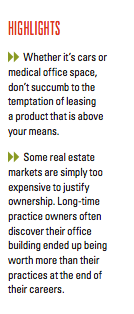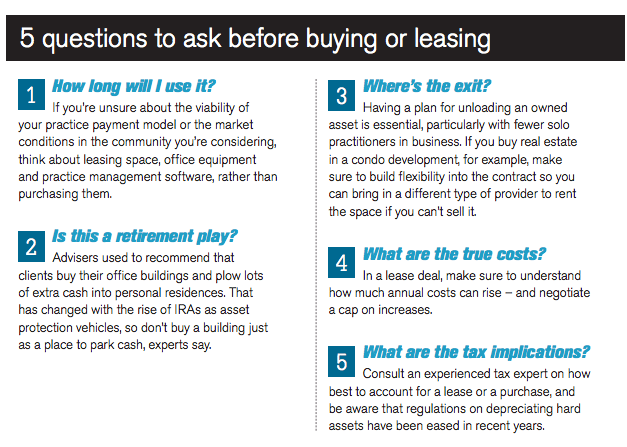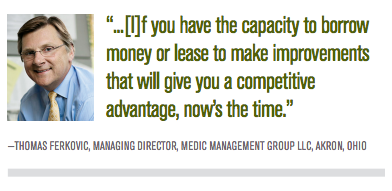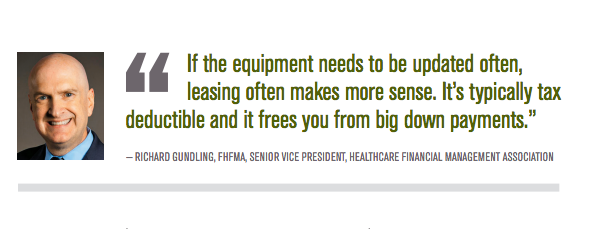Article
Buying versus leasing How to make the right choice
Author(s):
A sound financial decision on real estate and equipment requires considering unique circumstances.

Persistently low interest rates and uncertainty about the future business climate are steering more physicians to lease rather than buy many of the components of their practices.
Across all industries, equipment leasing and financing grew by 12% in 2015, according to the Equipment Leasing and Financing Association, though activity diminished somewhat in the early months of this year.
“If the equipment needs to be updated often, leasing often makes more sense,” says Richard Gundling, FHFMA, senior vice president for the Healthcare Financial Management Association. “It’s typically tax deductible and it frees you from big down payments.”
The downside, of course, is that leasing usually is costlier over longer periods of time, he says. In addition, the terms may not fit your needs and maintenance can sometimes be unreliable. There can be end-of-lease surprises and some physicians just may not like the lack of control over an asset.
So which way should physicians turn? Experts say practice owners should consider the terms of each buy/lease decision separately based on which is the most economical for the period of use, but also keeping in mind the long-term goals of the practice.
Cheap money
Ultra-low interest rates and technological advances are driving leasing and financing on nearly everything physicians would consider, from cars to software.

“Money is cheap right now and for any decent-sized practice the banks and finance companies are happy to lend to medical practices,” says Thomas Ferkovic, R. Ph., MS, managing director for Medic Management Group LLC in Akron, Ohio. Although the Federal Reserve raised interest rates at the end of 2015, they remain relatively modest.
“Banks are actively seeking out healthcare business. And if you think about the fact that at historically low rates, if you have the capacity to borrow money or lease to make improvements that will give you a competitive advantage, now’s the time,” Ferkovic says.
To determine which strategy is best, he talks with clients about the strengths of the practice and where the item to be acquired fits into the practice’s strategic plan. If there is a wide gap in total costs between buying and leasing over the period of time you are likely to need the asset, choose the most economical option, he says.
“Once you’ve decided there’s a negligible difference between paying cash or getting a good deal on a lease or finance program, then you look out two to three years and ask yourself whether you’ll need that cash for someone’s retirement from the practice or hiring new doctors,” he says. A substantial need there could tip the balance in favor of leasing today.

It’s important, however, to make the buy or lease decision in the context of what makes sense for a practice over the long term. “If I’m a 30-physician group and rapidly growing, I probably want to keep my capital dry to acquire new doctors, so I’ll lease my equipment,” Ferkovic says. “If I’m a 50-physician group and settling there I might want to own some assets.”
Still another factor to consider, experts say, is whether all the partners in a practice will stay around long enough to honor a lease. If a group leases a large piece of equipment, such as an MRI scanner, but then several partners leave and aren’t replaced, being stuck with the leasing expense of a larger practice can be crippling for the remaining partners.
And whether it’s cars or medical office space, don’t succumb to the temptation of leasing a product that is above your means, Ferkovic says. Determine first what spending level is appropriate for your practice size, then run the numbers to see if buying outright, leasing or financing is the best option, he says.
Tax man
Physicians should also weigh the tax consequences of leasing versus buying. Cari Weston, CPA, director of taxation for the American Institute of Certified Public Accountants, says business owners generally should lease items that won’t have much residual value to the practice once the lease expires, and buy those that will.
While leases generally had been considered a better tax move because leased business equipment can be deducted as an expense, recent regulations governing tangible property could tip the balance toward ownership, Weston says. Essentially the regulations, which have bee in effect since 2014, allow for accelerated depreciation on an owned asset.

And be sure your tax adviser is knowledgeable regarding all the leasing regulations. If someone pays 75% or more of an item’s value through a lease, for example, it must be capitalized and accounted for as a purchase, a point that is sometimes overlooked, Weston says. In other words, she says, make sure it is truly a lease and not a sale created to avoid depreciation costs.
If you decide to buy instead of lease, make sure the property-whether it is real estate, cars or other equipment-isn’t owned by the same entity that owns the practice, she says. “You never want the assets of the practice at the mercy of the building, and vice versa,” she says. “Keep everything in separate partnerships.”
While separate entities makes the paperwork and bookkeeping more cumbersome, each asset is subject to different sets of risk, Weston explains, so they need to be protected accordingly in the event of malpractice or other types of lawsuits.
Think like an owner
Lee P. Bee, DO, an internist in Sesser, Illinois, has heard the arguments for leasing office space, cars and medical equipment. They didn’t persuade him.
A solo practitioner since 2012, Bee owns his office building, and is building an urgent care facility nearby. He owns three EKG machines and a crash cart, and has an AED machine in every exam room. “I own the building and all the equipment, and I’m the IT guy, too,” he says.
Living in a low-cost real estate market certainly helps. He purchased his office building for about $80,000, including initial improvements, and owns the practice with no debt. Even in a larger real estate market, he believes savvy practice owners can find deals on space and equipment.
“My philosophy was to focus on the patient, not the pocketbook,” he says. By freeing himself from debt or lease payments, he can spend more time with each patient, rather than rushing them through to meet high revenue quotas, he says.
Finding a balance
Of course, some real estate markets are simply too frothy to justify ownership.
Long-time practice owners often find that their office building ends up being worth more than their practices at the end of their careers, says Gary Ware, principal of Practice Consultants in Danville, California. So if physician clients can handle the expenses of office ownership, he often recommends it. Of course, buying property incurs the very real risk that it value could decline as well as increase.
It’s also typically easier to secure financing for a piece of property than for a practice, Ware says, so for certain clients he recommends financing the hard assets of the practice while leasing other items, such as equipment.
The key, says Carr Healthcare’s Keck, is calculating the total costs of leasing versus buying over a time period that is meaningful to your practice. A typical rule-of-thumb, she says, is to think about how each strategy will impact the practice over the next decade. Will you or a partner be retiring in that time? Changing your practice model? Adding new outpatient services? All those factors need to be considered, she says.
“We look at the total cost of each strategy side by side, then have clients run both scenarios by their tax adviser,” she says.
Finally, remember to think about new ways to finance space. In some markets, for example, teams of physicians and dentists are creating new mixed-use facilities that incorporate non-medical retail space, enabling them to create new revenue streams and create foot traffic that attracts new patients, Keck says.
She adds that these spaces are getting bigger as more specialty types come together, from chiropractic to general practitioners, and financing can be challenging. Sometimes, she says, it becomes cost-effective to buy an even larger space if it comes with a lower cost per square foot, and then rent out the extra space.
Keck is seeing increased deal flow for both buying and leasing, after a few years of physicians selling out to hospital employment.
“They’re getting creative about the types of spaces they want to occupy, as well as the terms,” she says.




